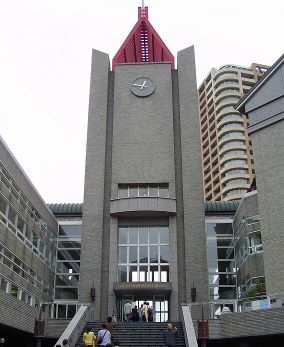
Waseda University, abbreviated as Sōdai (早大) is a private research university in Shinjuku, Tokyo. Founded in 1882 as the Tōkyō Senmon Gakkō by Ōkuma Shigenobu, the school was formally renamed Waseda University in 1902.

Takadanobaba is a neighborhood in Shinjuku, Tokyo, Japan.

The National Diet Building is the building where both houses of the National Diet of Japan meet. It is located at Nagatachō 1-chome 7–1, Chiyoda, Tokyo.
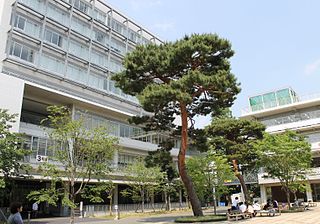
Seijo University is a private university in Seijo, Setagaya-ku, Tokyo, Japan. It is operated by the Seijo Gakuen institute. Seijo University has its origins in Seijo Gakuen (成城学園), which was founded in 1917 by Dr. Masataro Sawayanagi, a former Minister of Education. Under the pre-World War II education system it was called ‘Seijo Higher School’. It became Seijo University in 1950. As the founder Masataro Sawayanagi directed, the university values education of respecting and developing individual perspectives by providing a wide range of small-sized classes.

Favrile glass is a type of iridescent art glass developed by Louis Comfort Tiffany. He patented this process in 1894 and first produced the glass for manufacture in 1896 in Queens, New York. It differs from most iridescent glasses because the color is ingrained in the glass itself, as well as having distinctive coloring. Tiffany won a grand prize at the 1900 Paris Exposition for his Favrile glass.

Tokyo Midtown is a 569,000-square-meter mixed-use development in Akasaka, Tokyo, Japan. Completed in March 2007, the $3 billion project includes office, residential, commercial, hotel, and leisure space, and the new quarters of the Suntory Museum of Art. When completed, the Midtown Tower was the tallest building in Tokyo. The main building complex is surrounded by Hinokicho Park, a 10 acre public park containing green areas along with works of art.

Wakeijuku (和敬塾) literally meaning A Place to seek Harmony and Respect, is an all-male dormitory located in the Mejirodai neighborhood in the Bunkyō ward of Tokyo, Japan. Established in 1955 by Kisaku Mayekawa, philanthropist and founder of Mayekawa Manufacturing Company, Wakeijuku has been the home of students of Japanese universities for more than sixty years, including nearby Waseda University. Wakeijuku alumni include four former Japanese Prime Ministers, and notable Japanese author Haruki Murakami.
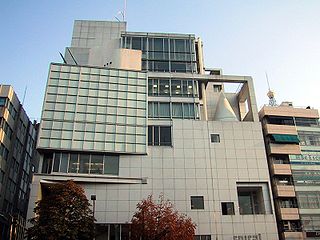
Spiral, also known as the Wacoal Art Center, is a multi-use building in Aoyama, Tokyo, Japan, that was designed by architect Fumihiko Maki. It was commissioned by lingerie company Wacoal and completed in 1985.
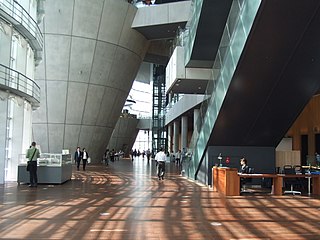
The National Art Center (NACT) is a museum in Roppongi, Minato, Tokyo, Japan. A joint project of the Agency for Cultural Affairs and the National Museums Independent Administrative Institution, it stands on a site formerly occupied by a research facility of the University of Tokyo.
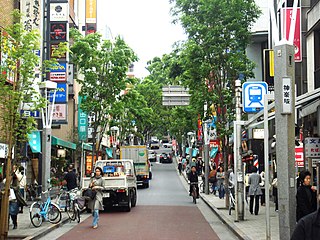
Kagurazaka (神楽坂) is a neighbourhood in Tokyo, northwest of Iidabashi Station. It has a shopping street at its center, lined by numerous cafés and restaurants. It is served by Tokyo Metro Tozai Line and Toei Oedo Line.

The Tokyo Metropolitan Teien Art Museum is an art museum in Tokyo, Japan.

Yotsuya-sanchōme Station is a railway station in Shinjuku, Tokyo Prefecture, Japan. Its station number is M-11.
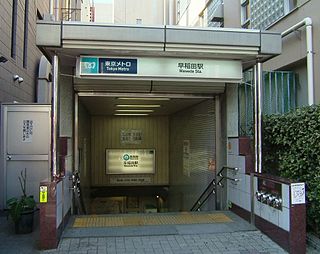
Waseda Station is a subway station on the Tokyo Metro Tozai Line in Shinjuku, Tokyo, Japan, operated by Tokyo Metro. Its station number is T-04. It is separate from Waseda Station on the Tokyo Sakura Tram.

Tama Art University or Tamabi (多摩美) is a private art university located in Tokyo, Japan. It is known as one of the top art schools in Japan.

21_21 Design Sight is a museum in Roppongi in Minato, Tokyo, Japan, which opened in 2007. The museum, a design museum, was created by architect Tadao Ando and fashion designer Issey Miyake. "The idea was to create not only a museum that shows exhibits," says Ando, "but also a place for researching the potentiality of design as an element that enriches our daily life, a place that fosters the public's interest in design by arousing in them different sights and perspectives on how we can view the world and the objects surrounding us." The building, designed by Ando, is on the edge of the park area, and features 1,700 square meters of floor space, including two galleries and an attached cafe run by chef and restaurateur Takamasa Uetake. The split-level concrete structure includes a hand-sanded steel roof and 14-meter (46 ft) long glass panels.
Von Jour Caux is the pseudonym of Toshiro Tanaka, a Japanese architect, artist, and thinker. He has been referred to as the Japanese Gaudi.

The Gorky Museum is an architectural landmark of the "Moderne" style, the Russian term for Art Nouveau. It was built in Moscow in 1900–02 by the architect Fyodor Schechtel. It is also known as the Ryabouchinsky House, for the young Russian industrialist and art collector who built it. After the Russian Revolution in 1917, the Ryabouchinsky family emigrated to France. In 1931 the Soviet government offered the house to the writer Maxim Gorky and his family. It was his home until his death in 1936. The widow of Gorky's son continued to live in the house until her death in 1965. It then became the Gorky Museum, dedicated to his life and work. It is located in the historic center of Moscow, at 6 Malaya Nikitskaya. Admission is free.












